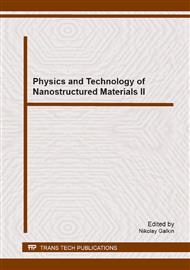p.35
p.42
p.47
p.51
p.56
p.60
p.65
p.71
p.80
Electrical Transport Features in Fe3O4/SiO2/n-Si Hybrid Structures
Abstract:
The temperature dependencies of the resistivity of planar structures Fe3O4/SiO2/n-Si, with Fe3O4 films of different thicknesses, were investigated. In the temperature range below 125 K, an anomalous decrease in the resistivity was observed. This effect is explained by switching of the conductance channel from the Fe3O4 film to the inversion layer of Si substrate due to the field-assisted tunneling of carriers through the semi-insulating Fe3O4/SiO2 double insulator. Confirmation was obtained by the current-voltage characteristics measured at 80 K. It was found that current-voltage characteristics are S-shaped and correspond to the MIS switch diode.
Info:
Periodical:
Pages:
56-59
Citation:
Online since:
March 2014
Keywords:
Price:
Сopyright:
© 2014 Trans Tech Publications Ltd. All Rights Reserved
Share:
Citation:


